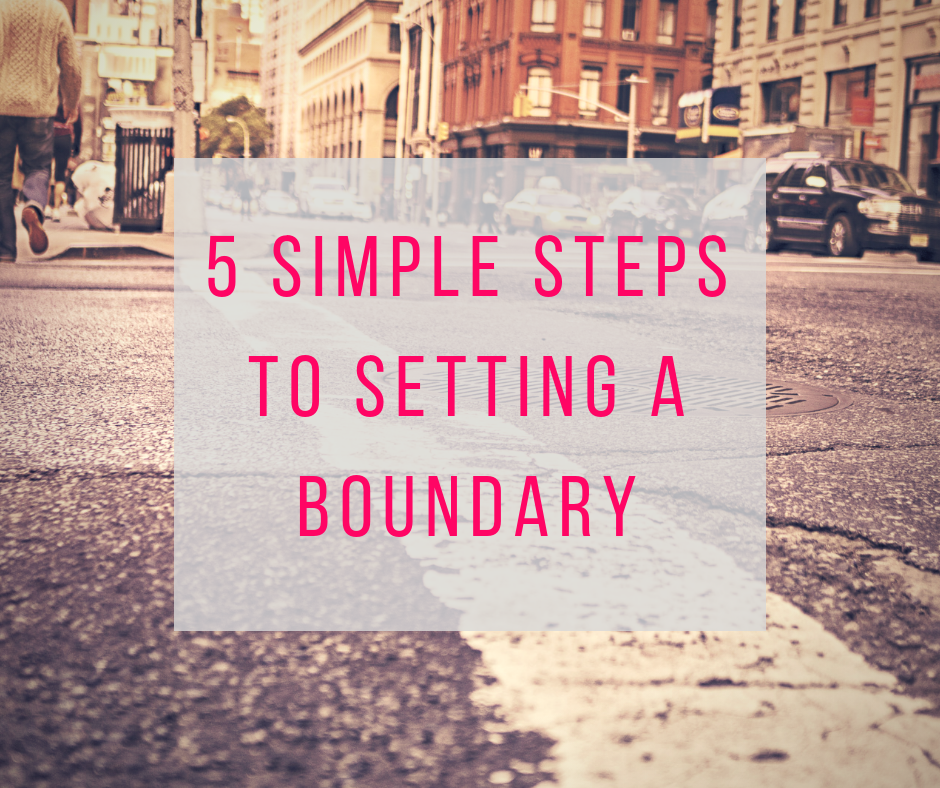Orlando Therapist Providing Relationship Therapy: 5 Simple Steps to Setting a Boundary
Orlando Therapist Providing Relationship Therapy: 5 Simple Steps to Setting a Boundary
Do you feel insignificant in your relationship? Does it feel like your partner mows over you and your wishes? After an argument, do you wonder, “What the heck just happened?” If this sounds like you, then this series on boundaries will help clarify what’s happening and help you get your feet back on the ground.
As an anxiety and trauma therapist providing counseling in Orlando, I want to help you set and maintain healthy boundaries in your relationships. A common misconception about boundaries is, “I told him not to do that anymore, and he did it anyway. He is not honoring my boundaries.” While this statement may be true, ultimately, the person responsible for “honoring” or carrying out your boundary is YOU.
In this article, I walk you through the 5 simple steps to setting a boundary. Setting a boundary is actually quite simple; it's not always easy, though. Let’s explore the nuts and bolts of setting and carrying out a boundary.
1. Know Yourself
When setting a boundary, explore what is happening within you. Are you feeling run over, disrespected, or taken advantage of? Investigate what is coming up for you around your partner’s action. Explore what is important to you in setting the boundary.
Know what action you are willing to take to back yourself up. Is this a deal breaker? Or is it an annoyance? Know where you stand. Make decisions about the action you are willing to take when you are calm and grounded, not when you’re mad. Do not put the relationship on the line if you aren’t willing to walk away.
I suggest you recruit the support of some trusted friends to help you sort out your feelings, where you stand, and what action are willing to take.
2. Be Clear
When setting a boundary, you need to be very clear with your words (how you communicate your boundary) and with your intentions (what you plan to do if your partner does not honor you boundary). It would sound like, “When you get drunk, I feel uncomfortable. I am asking you to stop. If you don’t stop, I will end the relationship.” Or, “When you look through my phone, I feel disrespected. I am asking you to stop. If you don’t stop, I will change my password so you can’t get in my phone.”
3. Give Them a Chance
This is the easy part and where many people stop. After you’ve communicated the boundary, the hope is, your partner will take it literally, honor it, and that is the end of the story. If this is the case, then yay! Give your partner some positive feedback and move along. If not, promptly move on to the next step and take the action.
4. Take Action
This is the hard part and where the rubber meets the road. The action you decided to take in step one and communicated in step two, needs to happen now. Taking this step empowers you. Not taking this step dis-empowers you. This is the “how to” behind the fun phrase, “You teach people how to treat you.” This step moves you out of being a victim in the relationship.
5. Get Support
Taking action is not easy and can bring up a lot of self-doubt, especially if you’re not used to standing up for yourself in a relationship. Have some trusted folks on the sideline ready to cheer you on and support you.
Have you tried to set a boundary in the past and things have fallen short? Do you draw a line in the sand and then move it? If so, check out my next blog post to explore what is preventing you from holding your ground.
Interested in How Therapy Orlando Helps?
At Mindful Living Counseling in Orlando, we offer guidance to help you process those painful experiences and develop healthier coping mechanisms. We'll work together through personalized therapy to build resilience and restore your sense of self. You deserve to find peace and happiness beyond the toxicity.
Fill out our New Client Consultation Form
Schedule a consultation call with one of our anxiety therapists.
Begin your healing journey!
Additional Orlando Therapy Resources
3 Fundamentals to Boundaries [+ 20 Q Self-assessment to Boot]
4 Boundaries for a Healthy Relationship and 14 Questions to See How You're Doing
Boundaries: 21 to Questions Uncover Your Style
Boundaries: 3 Reasons You Move the Line
Other Therapy Services Offered at Mindful Living Counseling in Orlando
We recognize that you might be dealing with various challenges, and we are here to support you. That’s why we provide a range of therapy services, such as Couples Therapy Orlando, Trauma Therapy Orlando, Anxiety Therapy Orlando, EMDR Therapy, Teen Therapy, and Guided Meditations. If you have any questions or need assistance, please feel free to contact us.
About Orlando Therapist: Lauran Hahn
Lauran Hahn is a therapist based in Orlando who specializes in providing EMDR Intensives to help clients address anxiety, trauma, and recover from unhealthy relationships. Alongside being a Certified Sensorimotor Psychotherapist and a Certified EMDR Therapist, Lauran holds the distinction of being an EMDRIA Approved Consultant. Her goal is to assist her clients in attaining a sense of calm in their bodies, achieving peace of mind, and cultivating meaningful relationships.





